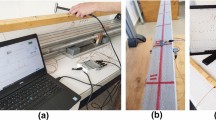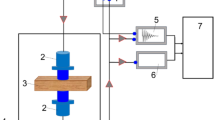Abstract
This paper focuses on the possibility of using sound spectral analysis as a diagnostic technique for the assessment of existing timber structures. The basic idea is to perform a spectral analysis, through the Fast Fourier Transform (FFT) algorithm, of the sound (recorded by a smartphone microphone) that is produced by hitting the wood surface of the element with a hammer or an equivalent tool. The sound spectrum is compared to a reference spectrum obtained for sound wood in standard environmental conditions in order to detect the presence of damage or decay. Differently from “classic” stress wave propagation methods that are based on the determination of the time-of-flight of the stress wave, the proposed technique relies on the local acoustic properties of wood. A first insight on the method applicability was obtained by testing the technique on several timber specimens in different conditions, from sound to completely decayed. Registration of the signals was performed by using two different mid-market smartphone models. Moment analysis, by calculating the spectral and frequency energy centroid of the sound spectra, was used to evaluate and compare numerous experimental recordings. The parameters that have the most significant impact on the sound signal (e.g. impact tool, microphone distance, boundary conditions, etc.) and that can negatively influence the assessment were then identified and investigated. Finally, pros and cons of the presented method and future developments are examined and discussed.
Access this chapter
Tax calculation will be finalised at checkout
Purchases are for personal use only
Similar content being viewed by others
References
Dackermann U, Crews K, Kasal B, Li J, Riggio M, Rinn F, Tannert T (2014) In situ assessment of structural timber using stress-wave measurements. Mater Struct
Ross R, Pellerin RF, Volny N, Salsig WW, Falk RH (2000) Stress wave timing non-destructive evaluation tools for inspecting historic structures: a guide for use and interpretation, Forest Products Laboratory
Kouroussis G, Fekih LB, Descamps T (2016) Using experimental modal analysis to assess the behaviour of timber elements. In: 5th seminar analyse vibratoire expérimentale, Blois, France
Xu F, Wang X, Teder M, Liu Y (2017) Acoustic impact testing and waveform analysis for damage detection in glued laminated timber, Holzforschung
Barré JB, Bourrier F, Brancheriau L, Bertrand D, Rey F (2017) Effects of fungal decay on elasticity and damping of small-diameter silver fir logs assessed by the transverse vibration resonant method, Wood Science Tech
Elwali W, Satakopan H, Shauche V, Allemang R, Phillips A (2010) Modal parameter estimation using acoustic modal analysis. In: Proceedings of the IMAC-XXVIII
Sobue N (1986) Instantaneous measurement of elastic constants by analysis of the tap tone of wood. J Jpn Wood Res Soc
Arriaga F, Morton J, Segues E, Íñiguez-Gonzalez G (2014) Determination of the mechanical properties of radiata pine timber by means of longitudinal and transverse vibration methods, Holzforschung
Ouis D (1999) Vibrational and acoustical experiments on logs of spruce, Wood Science Technology
Brancheriau L, Baillares H (2003) Use of partial least squares method with acoustic vibration spectra as a new grading technique for structural timber, Holzforschung
González MÁ, González MÁ (2016) Smartphones as experimental tools to measure acoustical and mechanical properties of vibrating rods. Eur J Phys
Audacity® audio editor and recorder. http://www.audacityteam.org/. Accessed 13 Nov 2017
European Committee for Standardization (2010) EN 408: Timber Structures – Structural timber and glued laminated timber – Determination of some physical and mechanical properties. CEN, Brussels, Belgium
Agilent Technologies, Appl. Note 243-3, The fundamentals of modal testing
Clifford A, Reiss JD (2011) Proximity effect detection for directional microphones. In: 131st audio engineering society convention
Acknowledgements
The research was financed by the 2018 ReLUIS Network (Italian Emergency Management Agency).
Author information
Authors and Affiliations
Corresponding author
Editor information
Editors and Affiliations
Rights and permissions
Copyright information
© 2019 RILEM
About this paper
Cite this paper
Riccadonna, D., Schiro, G., Casagrande, D., Piazza, M., Giongo, I. (2019). On the Use of Sound Spectral Analysis for the In Situ Assessment of Structural Timber. In: Aguilar, R., Torrealva, D., Moreira, S., Pando, M.A., Ramos, L.F. (eds) Structural Analysis of Historical Constructions. RILEM Bookseries, vol 18. Springer, Cham. https://doi.org/10.1007/978-3-319-99441-3_35
Download citation
DOI: https://doi.org/10.1007/978-3-319-99441-3_35
Publisher Name: Springer, Cham
Print ISBN: 978-3-319-99440-6
Online ISBN: 978-3-319-99441-3
eBook Packages: EngineeringEngineering (R0)




